Working with Prometheus 999
As some of you may be aware, I set myself a little challenge a wee while ago. I wanted to step outside of my comfort zone and explore some different types of silver clay other than the big brands of Precious Metal Clay (PMC) and Art Clay Silver (ACS) – both of which I love, both of which I have worked extensively with. I love them because they are predictable and they work well; when I open a packet, I know what I am going to get.
So stepping out of my comfort zone and exploring new clays was a bit scary – because apart from having that ‘oh shit – what do I make with this?’ moment, I don’t know what I am going to find when I work with them. All of the clays that I am testing have been bought by me, so I have absolutely no affiliation to any clay (in fact Silver Clay School is definitely brand neutral) and my opinion is just that – it’s an opinion and not influenced by anyone.
First Impressions
This time it was Prometheus 999. I have to say that when I got the packet, I was dubious straight away! It says on the front of the pack that it can be fired at 590oC for 1 hour and it’s strong. Well, that kinda goes against the grain because I have always had it drummed into me that fine silver needed to be fired at 900oC for 2 hours for maximum strength. But that’s what’s so good about trying something new, occasionally you will learn something 😉
Prometheus 999 – Straight out the packet
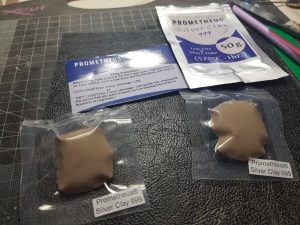 2 x 25g bags in a 50g bag of Prometheus 999
2 x 25g bags in a 50g bag of Prometheus 999
When I took the clay out of the packet and found two individually wrapped lumps of 25g. Now I like this – ACS do it too and I think it’s a great idea, because it means that you can manage your clay usage better. I wish Mitsubishi did the same thing with PMC!
Straight out the packet, the Prometheus 999 was stiff and quite unyielding. Trying to roll it into a ball in between my palms just didn’t work so well. I rolled it out flat (which it did well – without cracks) and added a spritz or two of water. On rolling it back up, it still didn’t roll together very well and I repeated the process. When I rolled it out flat to 4 cards thick, it began to curl up. Since this is my first bag of Prometheus 999, I am not sure if this is the clay itself and it’s working properties or if I just got a drier batch. However, I did find that I needed to add a reasonable amount of water to it to make it more workable.
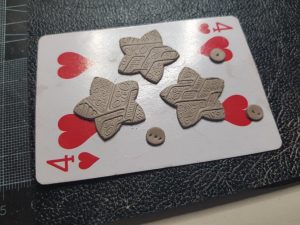 Rolled and textured Prometheus 999
Rolled and textured Prometheus 999
Despite that initial difficulty straight out the packet, it worked well. It took texture beautifully and dried easily. It did warp when drying in my dehydrator – but most clays do and that’s to be expected. It did have a reasonably good working time too, working well after being rolled, scrunched up and rolled again. several times.
Working with dry Prometheus 999
BUT when it’s dry – boy, does it feel robust! It feels very different to PMC and ACS (and more recently FYI). It’s a different colour – more steely grey than the cream of PMC or ACS, reminding me more of PMC Sterling . It’s very hard when it’s dry which makes for an interesting job when you want to refine and reshape your piece. And I must admit, I did struggle with that a bit and I didn’t enjoy the refining process very much.
When I spoke to a friend of mine who was also working with Prometheus 999 at the time about my experiences, she agreed with me. She also made a great suggestion to try using a metal file on the clay followed with wet sanding (either with a sponge or with a trusty baby wipe). That did work much better than trying to sand with 600 grit sandpaper, which quite honestly wasn’t up to the task.
My Chosen Projects
Since Prometheus 999 has such a low firing temperature, I thought it would be a good clay to try with glass. It’s ideal because glass needs to be fired at lower temperatures to stop it slumping or melting. Often this can lead to a design dilemma, where if you are firing fine silver clay at the lower temperature required by glass, you can be compromising on strength. This is because usually, fine silver clay needs to be fired high (900oC) and long (2 hours) for maximum strength. So with Prometheus promising strength after firing at such a low temperature as 590oC, it was essential to test it.
A word of warning…
Now Prometheus do offer a syringe version in their range of fine silver, but I didn’t invest in that (stupidly as it turns out). I just used my ACS 999 syringe to join the bails to the pendants. Normally fine silver will work well with fine silver and I have used PMC with ACS and FYI quite happily before. BUT I forgot a very important point – when I fired my pendants at the very low 590oC temperature, I forgot that the ACS syringe would not sinter at that temperature! This meant that my joins were weak which I promptly discovered when my fired pendant fell on the floor and broke ☹ That was totally my own fault and I should have thought about that beforehand. I could have easily bought the syringe or made my own paste to join the pieces together. I did make my own paste when I repaired, but more on that later…
Kiln Firing Results with Prometheus 999
The Prometheus 999 fired beautifully and came out of the kiln just as white as any other fine silver clay. I have to say that I was really surprised at this, since the prefired clay was so grey (more akin to Sterling clay that fine). And if I had joined the bail properly, I am absolutely certain there would have been no more problems.
It was also as strong as promised (apart from my broken bail which wasn’t the fault of Prometheus!).
I should also say that I fired Prometheus 999 on my ‘normal’ schedule i.e. 2 hours at 900oC and it fired well, with no issues.
Repairing a piece made with Prometheus 999
 Repaired pieces ready for kiln
Repaired pieces ready for kiln
When I discovered my weak joins, I kept the white pieces in order to repair them. I joined them together with some paste I made from the lump of Prometheus 999, some distilled water and some Paste Maker. I joined it as I would any other similar piece and when dry, tided up the join and popped back in the kiln at 590oC for an hour.
And this is where is gets a bit strange. The join didn’t work, it broke apart easily after coming out of the kiln and looking at the join, it looked as though the added clay did not sinter. I tried again and again and again with the same result. I can’t say for sure why this happened – whether the Prometheus 999 didn’t like being turned into paste or it didn’t like the added Paste Maker but something didn’t work. Not to be put off – I mean I was really happy with these two pendants and the beautiful cabs were donated by a top-notch glass worker – I tried again. But this time, I popped them in and fired at 700oC for 1 hour. Thankfully, this time the repair was good and all was well.
Handfiring Prometheus 999
I tried handfiring Prometheus 999 and this was a bit odd too. My first attempt didn’t go too well – the piece bubbled like cheese under the grill and was left looking like the face of a spotty teenager. I was perplexed – the piece was dry (I haven’t made that error in a while 😉). From that one time, I concluded that Prometheus 999 couldn’t be handfired.
BUT after some online investigation I saw from other Silver Clay artists that it could, indeed, be handfired, so, I tried again. And I tried 3 more times, just to be sure. I am very happy to report that my subsequent attempts went well – with no issues at all. I fired them for 5 minutes and the result was good.
On top of that, because of Prometheus’s claims about the 999 being strong – I dapped two pieces easily and successfully.
I couldn’t believe that! It’s not something I would do with handfired PMC or ACS – although to be completely transparent here, I have *never* tried although I might do now!
In Summary: Prometheus 999
To summarise then; I will work with this clay again. It’s lovely and strong and being able to fire it at such a low temperature without compromising on strength is a big bonus, especially if you work with glass. Plus the added benefit of being able to handfire makes it really accessible for students who are just starting out and don’t have a kiln. The price of this clay is amazing making it a good choice for the price conscious amongst us – I mean who doesn’t want to save money where they can? However, it isn’t the easiest clay to work with and I think the refining at leather hard stage is more difficult to do then with the likes of PMC, ACS or FYI. If you were to make more complex pieces with it, then this issue might be more difficult to overcome.
I bought my clay from Metal Clays 4 You, the website can be found here and the service and speed of dispatch was excellent.
You can get Prometheus 999 in the U.S. from here My suggestion? Give it a try. You might just find that the savings you make on the clay will make up for the extra bit of work you have to do at the refining stage. Oh and if you are making pieces with add ons and are going to be firing at 590oC make sure you invest in some Prometheus 999 syringe too 😊.
I hope this has been useful for you! Happy claying,
Love Emma xx


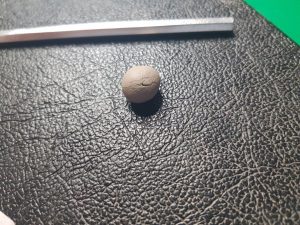
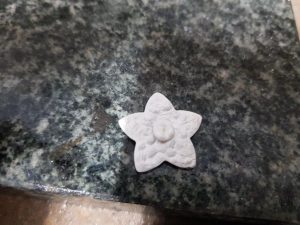
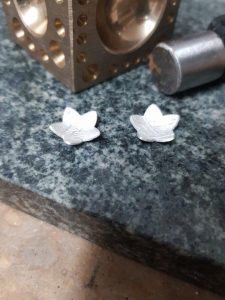
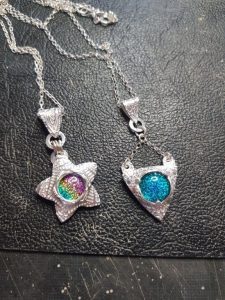





Hello Emma
Really appreciated your heartwarming honesty and open dialogue!
When your pockets are threadbare and your inner drive is a Ferrari it’s so refreshing to discover alternatives to the popular brands at Morris Minor prices🙂
Having qualified as a jeweller and printer and then running off in completely the opposite direction (cause Girls couldn’t find work as apprentices in fields designed for Boys when I was applying for jobs in small town NZ!) diving into University studying Anthropology, Sociology, Educational Psychology and Women’s History….then complete restoration and interior design of many houses 🤯😂
Looking forward to viewing the ins and outs of precious metal clay work on your site….after all learning feeds the soul without the calories.
kindly
G.G.